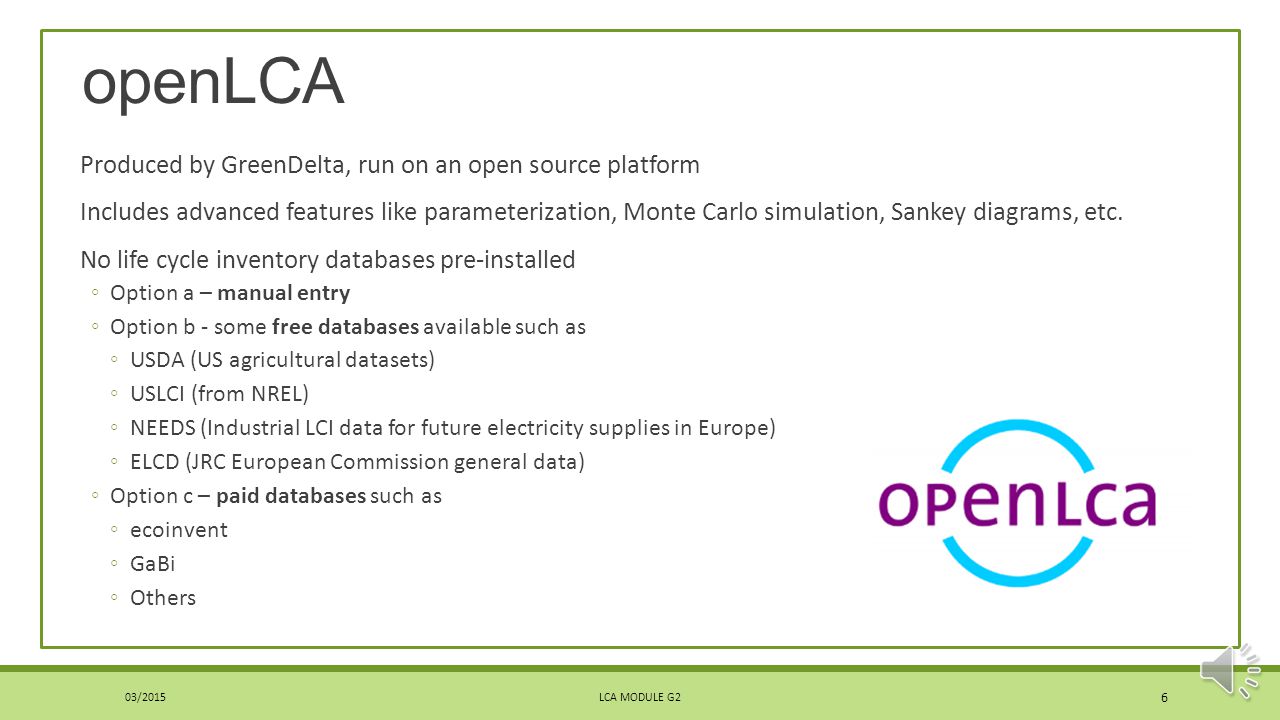
#OPENLCA USER MANUAL SOFTWARE#
The OpenLCA Project creates modular software for life cycle analysis and sustainability assessments.įig. So, the impacts could be analyzed according to a different process. A Sankey diagram depicts flows of impacts, where the width of each flow pictured is based on the number of influences. LCA software (such as SimaPro or OpenLCA) includes tools for drawing Sankey diagrams. Software for performing LCA (non-exhaustive list)
#OPENLCA USER MANUAL FREE#
In OpenLCA, which is a free LCA software, you could use different databases (such as ecoinvent) and evaluate different methods (such as ReCiPe) Table 1 shows some of the widely used software for LCA. The modeling of increasingly complex product systems and the proliferation of LCI (Life Cycle Inventory) data and impact assessment methodologies created a need for dedicated LCA software. Connection of keywords in research studies and clustering subjects

It could be found that the LCA is more connected to embodied energy, recycling, and building materialsįig. The connection between LCA and studied keywords is illustrated in Fig 4. Number of articles on LCA in various fields of study The critical point is the interdisciplinary nature of the use of LCA in engineering, which has emerged between the environment and civil engineering, mechanics, and industry.įig. 3 in terms of the number of works as it can be seen from this figure, environmental sciences with 709 environmental engineering with 685, building and construction technology with 545 and civil engineering with 492 works have the most sections. The study of LCA in various fields is shown in Fig. The publication of LCA articles on building materials and construction has been growing steadily since 1994, and its intensity has grown since 2013.įig. It is interesting to the researcher that the number of studies on LCA and construction is increasing dramatically.
#OPENLCA USER MANUAL ISO#
The framework of LCA modified from the ISO 14040 standard Applications of LCA are treated in separate publications from the standard organization the LCA framework operates with four different phases, Goal and scope definition, Inventory analysis, Impact assessment, and Interpretation.įig. 1, the ISO standard distinguishes the methodological framework of LCA from its different applications, which are multiple such as product development, Ecolabelling, carbon footprint, and other footprints. BREEAM, DGNB) by incorporating cradle-to-grave thinking while these systems, in turn, have contributed significantly to further development of LCA standards and methodologies.Īs illustrated in Fig. The application of LCA methodologies to buildings has strengthened building sustainability assessment systems (e.g. Either the comparison is made with the potential impacts of alternative design solutions, or the results are evaluated against a benchmark performance of the specific type of building and use.



LCAs within the building sector are mainly used to compare different choices of shape, design, or material at a single building level. This development of buildings towards increasingly complicated products coupled with relatively long product service lives makes LCA a prominent part of the environmental evaluation of buildings. Increasing regulatory requirements on the energy performance of buildings have taken the building design to ever more sophisticated levels where additional materials and technologies are used to reduce the energy consumed in operating the building and in providing for the needs of the users. When moving up to the city level, the impacts are more substantial: an estimated 70% of greenhouse gas emissions and over 66% of global electricity use emanate from urban activities. According to UNEP’s Sustainable Buildings and Climate Initiative, buildings account for 40% of global energy use, 38% of global greenhouse gas emissions, and 40% of the solid waste streams in developed countries. In terms of the scale of this resource use and environmental degradation, the contributions of buildings, and the built environment to global totals are significant. Since the oil crises in the 1970s, a significant concern within building design and operation has been to limit the need for operational energy and hence the demand for oil-based heating and electricity. By: Morteza Nikravan, Water & Environment Specialist, EDGE Expert


 0 kommentar(er)
0 kommentar(er)
